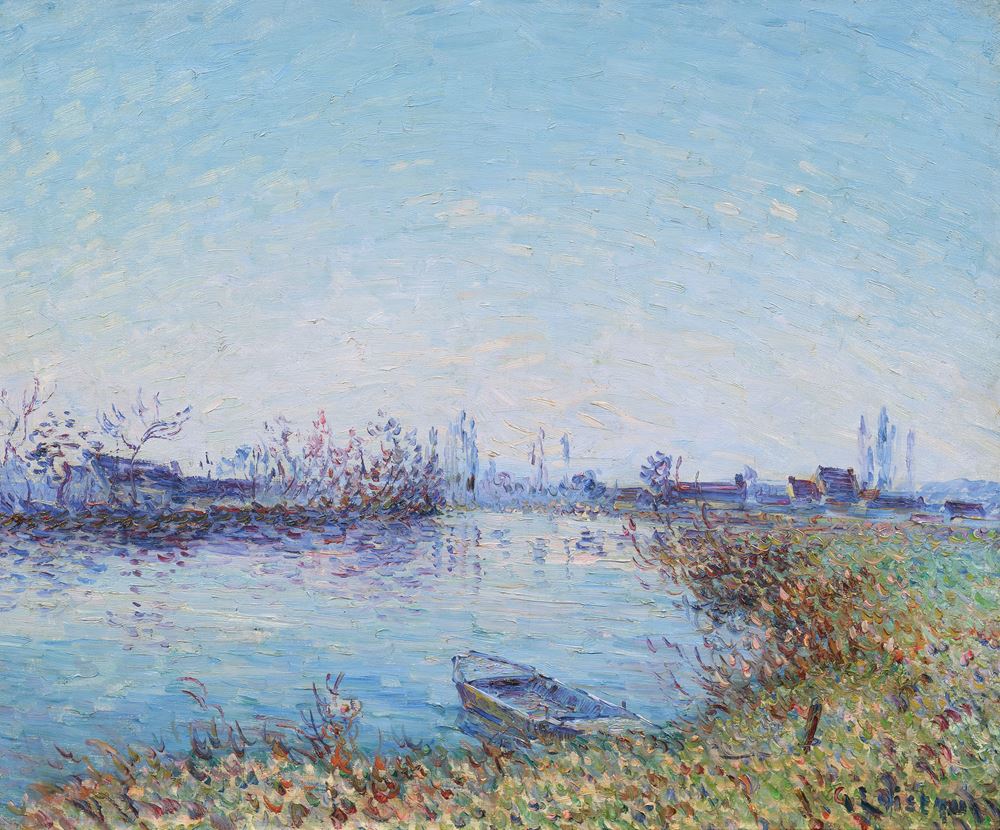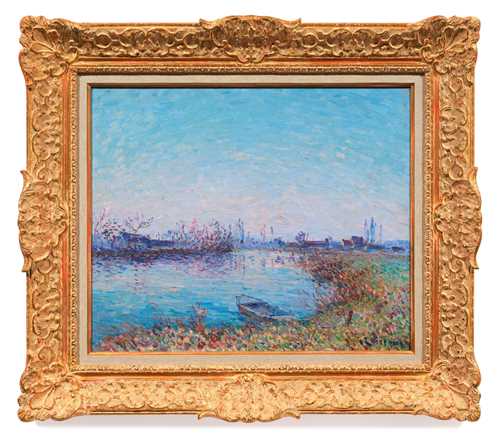
拍品 3206* - A207 印象派&现代主义 - Freitag, 01. Dezember 2023, 04.30 PM
GUSTAVE LOISEAU
(1865 Paris 1935)
Impression de gelée, le matin au soleil levant, Tournedos-sur-Seine. Circa 1899.
Oil on canvas.
Signed lower right: G. Loiseau.
Entitled verso on the stretcher: Impression de gelée, le matin au soleil levant, Tournedos sur Seine.
Entitled verso on the stretcher: Impression de gelée, le matin au soleil levant, Tournedos sur Seine.
54.5 × 65 cm.
Provenance:
- Paul Durand Ruel, Paris, acquired on 25.11.1899 directly from the artist.
- With Galerie Charpentier, Paris, acquired on 28.6.1945 directly from the above collector.
- With Galerie Ary Jan, Paris.
- Private collection, France, acquired from the above gallery.
As the "French Post-Impressionist" par excellence, Gustave Loiseau remained loyal to Impressionism throughout his life and, unshaken by parallel modernist art movements, developed his own visual language within Impressionist painting. After completing his studies at the École des Arts Décoratifs in Paris, Gustave Loiseau went to Pont-Aven in Brittany, where he came into contact with plein air painting. Initially inspired by Georges Seurat and Paul Signac's painting styles, he gradually emancipated himself from their influences and developed his own technique of pointillism. His painting style does not consist of strictly placed, uniform dots like Signac's, but of varying, impulsive strokes that reflect the meteorological and atmospheric conditions of the landscapes he depicted. Loiseau thus moved away from rationalized pointillism based on the laws of optics and advocates an emotional, more intuitive painting that better suited his shy nature. Strokes called "touche croisée" or "en treillis," combined with bright colors and an impasto technique, result in wonderful impressionistic landscape paintings. His preference for river landscapes, in which Loiseau explores different times of the day, seasons or weather conditions, is seen particularly in this painting. It features a vast sky composed of concentrically arranged brushstrokes, creating a halo effect. The celestial phenomenon is reflected in the clear water of the wide river. Along the horizon line, the use of violet and lilac tones reinforces the gentle autumn mood. The clear, light-flooded scenery allows viewers to see the contours of the houses on the other bank of the river clearly. This creates a cheerful, airy and atmospheric idyll.
Loiseau's success and popularity became apparent early on. As early as 1895 he was able to exhibit at the Salon des Indépendants in Paris. His works were highly praised by Parisian society and art critics. Paul Durand-Ruel, the famous gallery owner and most important supporter of Impressionist artists, was enthusiastic about his work and kept him under contract.
- Paul Durand Ruel, Paris, acquired on 25.11.1899 directly from the artist.
- With Galerie Charpentier, Paris, acquired on 28.6.1945 directly from the above collector.
- With Galerie Ary Jan, Paris.
- Private collection, France, acquired from the above gallery.
As the "French Post-Impressionist" par excellence, Gustave Loiseau remained loyal to Impressionism throughout his life and, unshaken by parallel modernist art movements, developed his own visual language within Impressionist painting. After completing his studies at the École des Arts Décoratifs in Paris, Gustave Loiseau went to Pont-Aven in Brittany, where he came into contact with plein air painting. Initially inspired by Georges Seurat and Paul Signac's painting styles, he gradually emancipated himself from their influences and developed his own technique of pointillism. His painting style does not consist of strictly placed, uniform dots like Signac's, but of varying, impulsive strokes that reflect the meteorological and atmospheric conditions of the landscapes he depicted. Loiseau thus moved away from rationalized pointillism based on the laws of optics and advocates an emotional, more intuitive painting that better suited his shy nature. Strokes called "touche croisée" or "en treillis," combined with bright colors and an impasto technique, result in wonderful impressionistic landscape paintings. His preference for river landscapes, in which Loiseau explores different times of the day, seasons or weather conditions, is seen particularly in this painting. It features a vast sky composed of concentrically arranged brushstrokes, creating a halo effect. The celestial phenomenon is reflected in the clear water of the wide river. Along the horizon line, the use of violet and lilac tones reinforces the gentle autumn mood. The clear, light-flooded scenery allows viewers to see the contours of the houses on the other bank of the river clearly. This creates a cheerful, airy and atmospheric idyll.
Loiseau's success and popularity became apparent early on. As early as 1895 he was able to exhibit at the Salon des Indépendants in Paris. His works were highly praised by Parisian society and art critics. Paul Durand-Ruel, the famous gallery owner and most important supporter of Impressionist artists, was enthusiastic about his work and kept him under contract.
CHF 100 000 / 150 000 | (€ 103 090 / 154 640)
以瑞士法郎銷售 CHF 125 000 (包含買家佣金)
所有信息随时可能更改。


